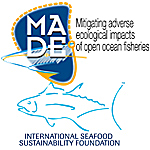A recent stock assessment of silky sharks (Carcharhinus falciformis) in the western and central Pacific Ocean (WCPO) showed significant declines in spawning biomass, total biomass and recruitment (WCPFC-SC8-2012). As a result silky shark interactions with tuna purse seine gear have become a subject of concern amongst scientists, managers and fishers. To address this and other bycatch issues the International Seafood Sustainability Foundation (ISSF) has initiated the #BycatchProject that supports research cruises in the world's oceans on commercial tuna purse seine vessels to develop ways to reduce fishing mortality on non-target species. One of the research objectives during the #BycatchProject cruise in the WCPO was to identify the point in the fishing operations when post-release survival rates of silky sharks is compromised. To answer this question blood chemistry analysis was done on animals landed during the different stages of the fishing operation with their post-release condition and survival verified with pop up satellite tag technology. Initial results indicate that animals landed and released early in the fishing operations (while still free swimming or entangled in the net during the net haul) had higher survival rates than animals landed during the brailing stages. Tag and blood chemistry data also show post-release survival to be significantly reduced once animals are confined in the sack. Thus efforts to promote the live release of sharks caught in the net need to be conducted during the early stages of the fishing operations.
- Presentation

 PDF version
PDF version
